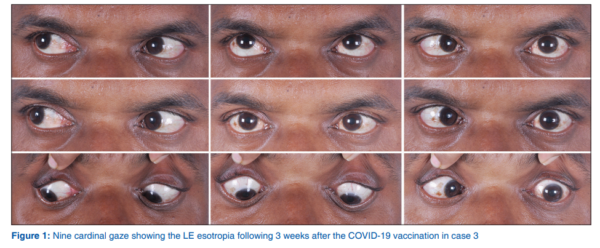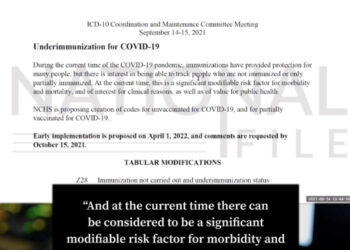Last Updated on December 18, 2022
Over 200 reported cases of uveitis, a form of eye inflammation which causes redness, pain and blurred vision, occurred in the U.S. after mRNA vaccine injections, according to the Vaccine Adverse Event Reporting System (VAERS), in addition to 132 reported cases of blindness in the United Kingdom, according to the UK’s Medicines and Healthcare products Regulatory Agency (MHRA).
The MHRA also reported an additional 6,682 eye disorders which followed COVID-19 injections across the pond.
In addition to inflammation, more serious adverse ocular side effects have been reported as well.
A study published in the Indian Journal of Ophthalmology documented four young adults who experienced “vaccine-related ophthalmic adverse events” despite the fact all patients were healthy, had no comorbidities, nor a prior history of COVID-19.
One was diagnosed with sudden-onset vertical gaze palsy, or an inability to look up. Another’s magnetic resonance imaging (MRI) was consistent with optic neuritis, or inflammation of the optic nerve, while another was diagnosed with acute 6th nerve palsy, which causes double vision and/or crossed eyes.
The fourth patient listed in the study had acute onset esotropia, a condition in which one eye is deviated inward.

“Nine cardinal gaze showing the LE esotropia following 3 weeks after the COVID-19 vaccination in case 3.”
A study published on August 23rd, 2021 detailed the occurrence of central retinal vein occlusion (CRVO) which immediately followed a 2nd dose of mRNA SARS-CoV-2 vaccine. CRVO is a condition in which the vein which drains blood from the retina is partially or completely closed, which can cause blurred vision and other sight problems. The patient in question was a 50-year-old “healthy non-obese and non-smoking” person.
The patient experienced “retrobulbar pain,” or pain behind his eye, in addition to redness and vision reduction.
The scientists who published the study reasoned that this report suggests that both mRNA-based and adenovirus vector vaccines can cause “thromboembolic events” or blood clots which are caused by other blood clots.
“The CRVO immediately following the 2nd vaccination with an mRNA-based vaccine in an otherwise healthy patient suggests that thromboembolic events may not only occur in vector-based but also in mRNA-based vaccines,” the authors wrote in their study.
Another study collated 58 different documents, which included case reporters, photo essays, and a letter, the total data of which documented 94 patients with “adverse ocular events.”
Of the 87 patients for which vaccine info was available: 55 were given the BioNTech/Pfizer vaccine, 20 people used AstraZeneca, six used Moderna, three people used BBIBP-Corv (China), two people used Corona Vac (China), and one person used Russia’s Sputnik V vaccine.
“Vaccination-induced cranial nerve palsies have previously been reported following the influenza, hepatitis B, smallpox, and MMR vaccines. While the exact mechanism has not been elucidated, vaccine-induced cranial nerve palsies are believed to be due to immune-mediated damage resulting in demyelination or vascular compromise resulting in reduced blood flow. Given the aforementioned links between vaccination and vascular compromise as well as autoimmune phenomena, it is likely that these underlie the development of ocular motility disorders following COVID-19 vaccination.”
“Ocular Complications Following Vaccination for COVID-19: A One-Year Retrospective” by Abid A. Haseeb, Omar Solyman, Mokhyat M. Abushanab, Ahmed S. Abo Obaia, and Abdelrahman M. Elhusseiny.





















